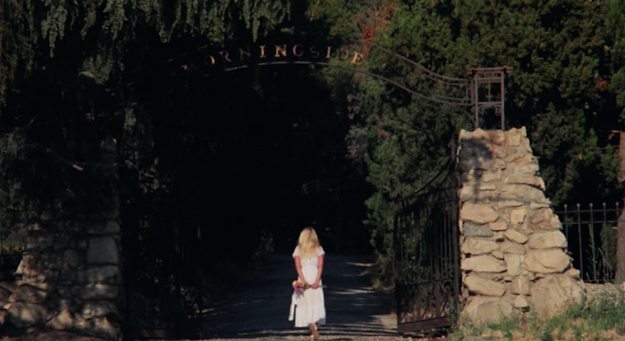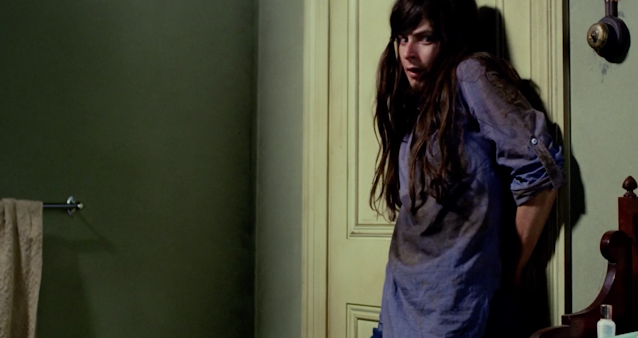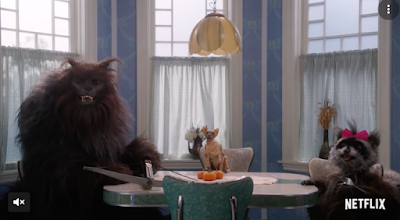 In short, Paul Naschy, over the course of his countless "Valdemar" movies, became the werewolf we never really got from Lon Chaney Jr., who spent all of the sequels trying to die, chasing the scientists who inevitably bring 'the Monster' back, movie after movie, making us all wonder why he doesn't just jump into the nearest threshing machine instead of moping around like that guy who's always threatening suicide if you try to break up with him. For some reason his brooding Edwardian emo persona attracts all sorts of smitten gypsy girls. And there's a full moon tonight!
In short, Paul Naschy, over the course of his countless "Valdemar" movies, became the werewolf we never really got from Lon Chaney Jr., who spent all of the sequels trying to die, chasing the scientists who inevitably bring 'the Monster' back, movie after movie, making us all wonder why he doesn't just jump into the nearest threshing machine instead of moping around like that guy who's always threatening suicide if you try to break up with him. For some reason his brooding Edwardian emo persona attracts all sorts of smitten gypsy girls. And there's a full moon tonight!
I mention this as Naschy talks about falling love with horror after seeing Frankensstein meets the Wolfman in a matinee with his father as a child. His whole werewolf journey seems designed to redeem that movie. Always sensual and ready to fondle and make-out with anyone, burly body-builder Naschy's squat, ruggedly handsome physique and even-keeled manner imbues his Valdemar with a romantic nature that's inherently aristocratic yet sexually proletariat at the same time. He's the werewolf we always wanted, even if his make-up is nowhere near as elaborate. (though I've never been a fan of Chaney's wolf face - too pouffy and poodle-like; I much prefer the less extreme but scarier version in the underrated Werewolf of London. )
The focus here isn't on Naschy though. He's great but the focus is on three super gorgeous tourists coming to a remote tomb on a holiday, wanting, for some reason, to revive,Elisabeth Bathory (we see her and her minions put to death in the Middle Ages opening, as was the style of the time). The leader of the trio is totally evil (ala Tura Satana in Faster Pussycat) while the other two girls seem rather naive, along for the ride. One can't help but admire their brazen self-assurance in their mission, despite all the warnings from locals. Plunging fearlessly into a vast cave network to find the tomb of the most eveil serial killer ever, Elizabeth Bathory, they're set on becoming her vampire handmaidens. The 'good' one amongst them falls for Vlademamir but will she be able to kill him when the time comes?
It's another interesting echo of FVTWM that Valdemar has a deformed servant in love with him (ala the hunchbacked gypsy girl turned on by Chaney's emo vibes). Half her face is burnt, but her hair is great. In fact all their hair is great, the same color, long brown and more or less straight. Clearly Naschy has a type. But it's a good type, and these women are strong and self-reliant. Not only that but there are way more in the cast than men, making Night reminiscent of the films of Luigi Cozzi! And Jack Hill!)
In other words, Night of the Werewolf is revisionist classic Euro-horror heaven for the Universal and Euro horror fan. And the cinematography--thanks to a wondrous recent restoration--glows with lots of candle and torchlight golds, deep inviting shadows and swirling luminous fog. It's lovely to look at, and aside from the sex and gore, is fit entertainment for the whole family if the kids are too old to trick-or-treat.
A once nearly-forgotten cracked emerald in the American rough, recently given a fancy upgrade by the folks at Arrow, The Child may be set in some remote 30s-40s corner of woodsy mountainous American folk nowhere, but its real location is the dream nebula where childhood nightmares rattle bedroom shutters in the still of the October night in the land of super quiet, super black nights only cloudy country nights provide (that kind of darkness and dead silence are why I live in the city and sleep with a white noise machine) and unearthly squawking moans seem to come from the air itself. Shoehorning themes and moods from Night of the Living Dead and The Omen in amidst its folk horror ominousness, The Child tells the story of a strange but sweet young woman, with period length long straight black hair and strange silver eyes, who arrives to nanny a bratty 11-year old sociopath named Rosalie (Rosalie Norton) after the apparent death of her (bi-polar necromancer) mom. Rosalie's dad is only a shades less demented than the dad in Texas Chainsaw Massacre. Luckily, the adult son is tall, chill, and sane, thank God, and there's not much to do there in the dark at night, so they just may hook up, or he might turn into a scarecrow while she dances through the misty front lawn dream on Halloween night after freaking out at the sight of a jack-o-lantern seemingly moving on its own.
There's a masterful use of real darkness here that's rare in horror films (that jack-o-lantern seems to come out of nowhere). Yessir, The Child radiates a real country dark, the kind that seem to swallow the world around you, so that someone could be standing mere feet away from you and you'd never see them, so you strain to hear any sound of breathing in the silence, the kind of dark of where only candles and oil lamps make little bubble sancturaries of warmth and light in the surrounding inky opaque emptiness,. (1)
It took me a long time to warm up to this weird gem, being too cool for what I believed was misogynist gore as a teenager, but after catching the other films in Fulci's undead trilogy, City of the Living Dead (1980) and House by the Cemetery (1981) on TCM, I knew I was wrong. There was so much more here than that. And so much less. Now, thanks to the miracle of streaming, a beautiful HD remastering is ours for the clicking. Sure, it defies narrative cohesiveness and seems to exult in gore for gore's sake, but it's so atmospheric! It's what Fulci meant by an 'absolute' film. A pumpin' Fabio Frizzi synth and pianocore, a script that's just cohesive enough to make the weirdness continually 'dream logical,' ambiguous expressions that seem to imply pages of strange suspicion never written. It's so 'in the moment' it forgets all about the future, leaving us constantly on our guard. Everything is just off. There is 'normal' moment we expect having seen hundreds of horror movies, the foreshadowing is its own uncanny effect with no pay-off, and vice versa. The result is that even minor details seem that's not imbued with the uncanny. From the start with a period prologue of Shrike the warlock painter's torture crucifixion (nailed to a wall, doused in lye, flogged with chains (we never learn why) and walled up in the basement of the "7 Doors Hotel" thus opening one of the seven doors to Hell), all the way to contemporary times, as Liza (the perfectly-cast, instantly iconic Catriona MacColl) inherits the crumbling edifice and sends Joe the plumber down to the vast, flooded basement to stop the leak. The painting the warlock was working on when he died is gathering dust on the ground floor, a strange hellscape that looks like the surface of some macabre moon, dotted with corpses covered in dust. Workmen fall off the roof, Joe busts through a crumbling wall allowing the warlock's decaying hand reaches from the crumbling wall to crush his face. Joe has a funeral minutes later. There is never a police investigation nor a single cop in the whole movie; we never see anyone even find Joe's eyeless body - it just shows up in the morgue. Shrike's eerie painting is hung in the foyer where its strange power seems to take over those who look at it. At one point it bleeds. For some reason the intern in the space age morgue puts an EKG meter on Shrike's long dead corpse which is now laid out next to Joe's; again no explanation - none needed. Shrike waits til he's alone to activate the EKG. Oh, he's in there, all right. To have some tired rationale would lessen its majesty. Hell-that's all you need to know, a hell where the undead shamble through hospitals with their heads down, shambling slow, like the workers in Metropolis after a long shift.
Liza scoffs at the idea of the hotel leading to Hell, even though the service buzzer mysteriously sounds for the warlock's old room at odd times and she almost literally runs into a willowy blind blonde psychic Emily (Cinzia Monreale) with greyed over eyes and a seeing eye dog standing in the middle of straight bridge the goes on for miles over the swamps. Emily plays the ominous theme song on the piano, while regaling Liza with the story of the seven doors (which we never really hear or need to) we move onto other things and then come back. We never quite do find our way back anywhere, except this one time. When Liza arrives back at the hotel dimwitted handyman and his mom get the hotel almost ready to open. The painting is still there leaning against the wall. There is no 'normal' to ground us, yet nothing seems weird for weird's sake like so many 80s horror and sci-fi films. Instead 'the frame of things disjoint' (to quote Shakespeare. The doctor (David Warbeck) alone is the sole voice of patriarchal head-shaking; he worries Liza is losing her mind, or a witch, but not for long. The book shows up in a bookstore then disappears. Tarantulas take about a real time hour to eat a guy's face. The lady housekeeper has her head forced onto one of those Shrike nails by the handyman who arises from the muddy water in the bathtub. Space collapses. Nothing is the same or ever really was.
Don't ask. Don't tell. Just dig the unforgettable shots: Emily standing with her dog and white eyes; the blasted surface of the Sea of Darkness; that strange all-white morgue; the masterfully creepy zombies shattering a opaque glass wall; the strange glances, the gore, the guts, the gusts and the gusto; the crisp atmospheric photography of Sergio Salvati (perfectly brought out by the HD remastering), and Fabio Frizzi's eerie synth music and strange piano refrains. Let it swirl together like a film that's spun off its reel and is wrapping itself around your neck, dragging your eye closer... closer to the hot light inside the proector. Allow it to sync up with your unconscious rather than your conscious expectations and it will all make perfect non-nonsense. You'll either want to vomit and gouge your eyes out or immediately cue up Fulci's other films. There is no middle ground. All hail the... whatever.
This 1982 Aussie thriller has been seldom seen or mentioned until recently Perhaps its bland poster and generic title is to blame? It's got a unique plot, friendly characters, vivid deep dusky cinematography, very cool wallpaper, and a sublime Klaus "Tangerine Dream" Schulze score adding the perfect mix of otherworldly eeriness to the homey surroundings. The sliding camera and dark furnishings keep us always on guard, even when things are all in order and sweet.
Jacki Karin stars and brings a mix of steely energy and frazzled nerves to the role of Linda, a woman who inherits her recently deceased mom's old folk's home somewhere in Australia's vast outback, so drives in to both take over and figure out what's going on with all the deaths. Reading mum's journals she can't decide if the mom is insane or covering up or trying to solve a decade's long murder spree. At night the camera prowls the dark moody hallways, as Linda has pull-focus slow motion POV memories of being a traumatized child. What horrifying thing did she see in the steamy bathroom?
With Schulze percolating his eerie but synth drum-inundated score as the wallpaper and lighting making it all feel like some splendid hybrid between Kubrick's Shining and Nicolas Winding Refn's Only God Forgives. The strange goings on get stranger. Good thing her old friend and ex-lover Barney (John 'Wolf Creek' Jarrat!) is around to keep her grounded! To say much more about it would be doing you a disservice but suffice it to say this film evokes a kind of warm-blooded Shining if it was an active old folks home about to collides nto a kind of four alarm Chainsaw-ish whirlwind of strange and ingenious moments, captured with beautiful dusky cinematography. See it with the lights off, dead sober, alone, your nerves dilated and screaming with alcoholic withdrawal. You will be changed.

8. THE UNDEAD
(1957) Dir. Roger Corman
streaming Prime, Tubi









































